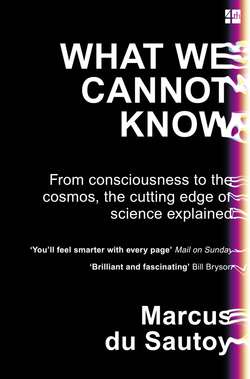Читать книгу What We Cannot Know: Explorations at the Edge of Knowledge - Marcus Sautoy du - Страница 13
1
ОглавлениеThe unpredictable and the predetermined unfold together to make everything the way it is. It’s how nature creates itself, on every scale, the snowflake and the snowstorm. It makes me so happy. To be at the beginning again, knowing almost nothing.
Tom Stoppard, Arcadia
There is a single red dice sitting on my desk next to me. I got the dice on a trip to Las Vegas. I fell in love with it when I saw it on the craps table. It was so perfectly engineered. Such precise edges coming to a point at the corners of the cube. The faces so smooth you couldn’t feel what number the face was representing. The pips are carved out of the dice and then filled with paint that has the same density as the plastic used to make the dice. This ensures that the face representing the 6 isn’t a touch lighter than the face on the opposite side with a single pip. The feeling of the dice in the hand is incredibly satisfying. It is a thing of beauty.
And yet I hate it.
It’s got three pips pointing up at me at the moment. But if I pick it up and let it fall from my hand I have no way of knowing how it is going to land. It is the ultimate symbol of the unknowable. The future of the dice seems knowable only when it becomes the past.
I have always been extremely unsettled by things that I cannot know. Things that I cannot work out. I don’t mind not knowing something provided there is some way ultimately to calculate what’s going on. With enough time. Is this dice truly so unknowable? Or with enough information can I actually deduce its next move? Surely it’s just a matter of applying the right laws of physics and solving the appropriate mathematical equations. Surely this is something I can know.
My subject, mathematics, was invented to give people a glimpse of what’s out there coming towards us. To look into the future. To become masters of fate, not its servants. I believe that the universe runs according to laws. Understand those laws and I can know the universe. Spotting patterns has given the human species a very powerful way to take control. If there’s a pattern then I have some chance to predict the future and know the unknowable. The pattern of the Sun means I can rely on it rising in the sky tomorrow or the Moon taking 28 sunrises before it becomes full again. It is how mathematics developed. Mathematics is the science of patterns. Being able to spot patterns is a powerful tool in the evolutionary fight for survival. The caves in Lascaux show how counting 13 quarters of the Moon from the first winter rising of the Pleiades will bring you to a time in the year when the horses are pregnant and easy to hunt. Being able to predict the future is the key to survival.
But there are some things which appear to have no pattern or that have patterns that are so complex or hidden that they are beyond human knowledge. The individual roll of the dice is not like the rising of the Sun. There seems to be no way to know which of the six faces will be pointing upwards once the cube finally comes to rest. It is why the dice has been used since antiquity as a way to decide disputes, to play games, to wager money.
Is that beautiful red cube with its white dots truly unknowable? I’m certainly not the first to have a complex relationship with the dynamics of this cube.
